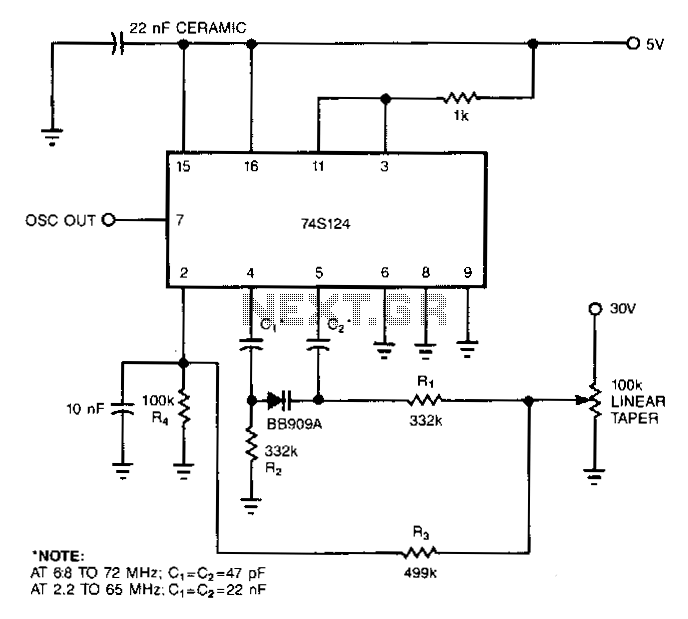
Variable-capacitance-diode-sparked-vco

A 7415124 multivibrator can be converted into a wideband voltage-controlled oscillator (VCO) by substituting the conventional fixed capacitor with a variable-capacitance diode. The primary drawback of this configuration is the 30-V biasing voltage required by the diode. Capacitors C1 and C2 connect the Philips BB909A variable-capacitance diode to the 7415124. Resistors R1 and R2 are sufficiently large to isolate ground and control voltages from the timing capacitors. Resistors R3 and R4 create a voltage divider for the control input of the 7415124.
In this circuit, the 7415124 multivibrator serves as the core oscillator component, providing a stable oscillation frequency that can be modulated by varying the capacitance of the BB909A diode. The diode's capacitance changes in response to the applied reverse voltage, which is determined by the control voltages supplied through the voltage divider formed by resistors R3 and R4.
Capacitors C1 and C2 are essential for coupling the variable-capacitance diode to the multivibrator. They ensure that the AC signals can pass while blocking any DC components, thereby maintaining the integrity of the oscillation. The careful selection of these capacitors is crucial, as they must be compatible with the frequency range of interest and the characteristics of the diode.
Resistors R1 and R2 play a significant role in isolating the timing capacitors from ground and control voltages. This isolation is vital to prevent any unwanted loading effects that could distort the oscillator's performance. The values of R1 and R2 should be chosen to ensure minimal interaction with the timing capacitors while providing adequate control over the oscillator's frequency.
The voltage divider formed by R3 and R4 is used to set the control voltage for the diode. By adjusting the values of R3 and R4, the biasing voltage applied to the diode can be finely tuned, allowing for precise control over the oscillation frequency. It is important to ensure that the voltage divider does not draw excessive current, which could affect the overall stability and performance of the VCO.
In summary, this configuration of the 7415124 multivibrator with a variable-capacitance diode offers a versatile approach to generating wideband oscillations. However, careful attention must be given to component selection and circuit design to mitigate the drawbacks associated with the high biasing voltage and to ensure optimal performance of the voltage-controlled oscillator.You can transform a 7415124 multivibrator into a wideband VCO by replacing it conventional fixed capacitor with a variable-capacitance diode. The only disadvantage of this scheme is the 30-V biasing voltage that the diode requires. Capacitors C1 and C2 couple the Philips BB909A variable-capacitance diode to the 745124. R1 and R2 are large enough to isolate ground and control voltages from the timing capacitors. Resistors R3 and R4 form a voltage divider for the 745124"s control input.
In this circuit, the 7415124 multivibrator serves as the core oscillator component, providing a stable oscillation frequency that can be modulated by varying the capacitance of the BB909A diode. The diode's capacitance changes in response to the applied reverse voltage, which is determined by the control voltages supplied through the voltage divider formed by resistors R3 and R4.
Capacitors C1 and C2 are essential for coupling the variable-capacitance diode to the multivibrator. They ensure that the AC signals can pass while blocking any DC components, thereby maintaining the integrity of the oscillation. The careful selection of these capacitors is crucial, as they must be compatible with the frequency range of interest and the characteristics of the diode.
Resistors R1 and R2 play a significant role in isolating the timing capacitors from ground and control voltages. This isolation is vital to prevent any unwanted loading effects that could distort the oscillator's performance. The values of R1 and R2 should be chosen to ensure minimal interaction with the timing capacitors while providing adequate control over the oscillator's frequency.
The voltage divider formed by R3 and R4 is used to set the control voltage for the diode. By adjusting the values of R3 and R4, the biasing voltage applied to the diode can be finely tuned, allowing for precise control over the oscillation frequency. It is important to ensure that the voltage divider does not draw excessive current, which could affect the overall stability and performance of the VCO.
In summary, this configuration of the 7415124 multivibrator with a variable-capacitance diode offers a versatile approach to generating wideband oscillations. However, careful attention must be given to component selection and circuit design to mitigate the drawbacks associated with the high biasing voltage and to ensure optimal performance of the voltage-controlled oscillator.You can transform a 7415124 multivibrator into a wideband VCO by replacing it conventional fixed capacitor with a variable-capacitance diode. The only disadvantage of this scheme is the 30-V biasing voltage that the diode requires. Capacitors C1 and C2 couple the Philips BB909A variable-capacitance diode to the 745124. R1 and R2 are large enough to isolate ground and control voltages from the timing capacitors. Resistors R3 and R4 form a voltage divider for the 745124"s control input.